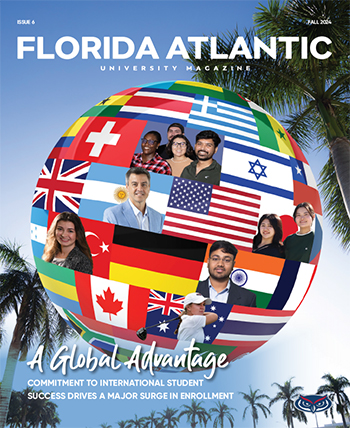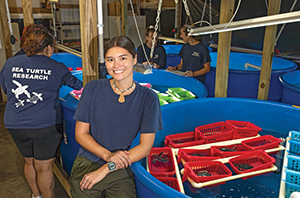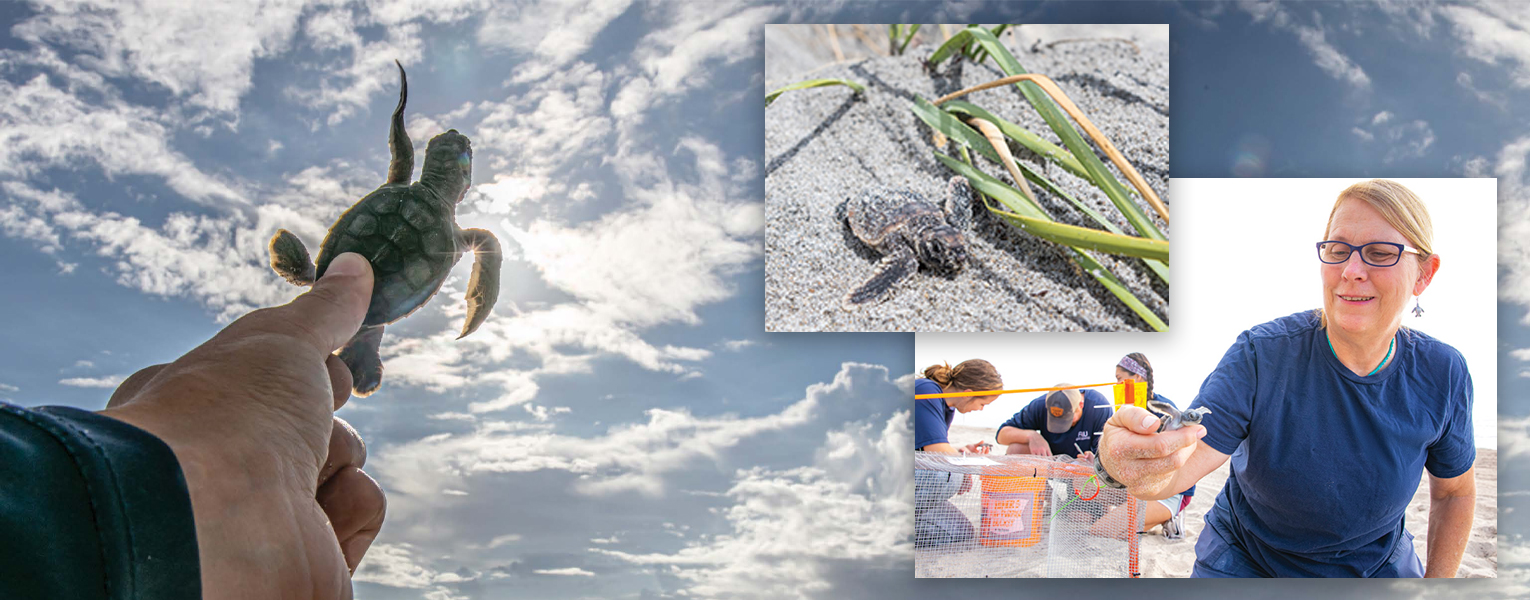In Hot Water
Trailblazing Trio Leads the Fight to Save Florida’s Sea Turtles
In a state known for its pristine beaches and diverse marine life, three Florida Atlantic University researchers have devoted their careers to understanding and protecting vulnerable sea turtles. Jeanette Wyneken, Ph.D.; Sarah Milton, Ph.D.; and Annie Page, DVM, Ph.D., make up a talented trio that bring a unique skill set to each of their conservation efforts.
A prevailing catalyst that propels their research focus is escalating temperatures and its repercussions. For sea turtle hatchlings in particular, survival is already an uphill battle. On average, about 1 in 1,000 survives to adulthood. Many are lost to misadventure and often become prey for other organisms. Now, extreme heat is taking their chances for survival to new levels.
For more than three decades, Wyneken, a professor in the Department of Biological Sciences in the Charles E. Schmidt College of Science, has been studying the impacts of local environmental conditions on sea turtle development, sex ratios and dispersal. Her long-term research of nest temperatures and primary sex ratios demonstrate how species differ in their responses to changing climate and weather conditions.
“The sex of sea turtles is determined by the temperature at which the eggs incubate. This process is referred to as temperature-dependent sex determination. Higher temperatures result in more female hatchlings and lower temperatures result in more male hatchlings,” Wyneken said.
Her students coined the phrase “hot chicks and cool dudes” to help others understand the system.
Florida is home to five species of sea turtles: green, leatherback, loggerhead, Kemp’s ridley and hawksbill — all of them protected species. The most commonly found sea turtles in South Florida are green, loggerhead and leatherback turtles. In fact, Florida hosts about 90% of all the Atlantic loggerhead nests. Most of the loggerhead nesting takes place on the east coast of Florida in Brevard, Indian River, St. Lucie, Martin and Palm Beach counties.
In 2002, Wyneken and her students began monitoring loggerhead sea turtle nest temperatures. Within a few years, they added similar studies of green and leatherback sea turtle nests in Palm Beach County to check the temperature of the incubating eggs. The objective is to understand local nest temperatures and resulting sex ratios. Ideal temperature range for a nest under the sand is about 75 to 85 degrees Fahrenheit.
“In our first year, we found that 65% of the loggerhead hatchlings were female, which we now attribute to cooler beaches because of a lot of rain,” Wyneken said. “However, the following year, which was much drier, females accounted for about 95% of the mix, and the next year it was hot and dry longer, producing 98% females.”
Since then, Wyneken and her team of up-and-coming biological scientists have found between 98% to 100% female nests in most years, a very worrisome discovery. This sex ratio imbalance means not just that South Florida is no longer “where the boys are,” but is instead a wake-up call that the world is getting hotter and it’s not just affecting sea turtles.
“Sea turtles serve as sentinels, offering invaluable insights into climatic change and its effects on marine ecosystems, thereby serving as pivotal indicators of environmental change,” Wyneken said.
Wyneken’s groundbreaking research doesn’t just take place in the field. Housed in the Gumbo Limbo Environmental Complex in Boca Raton, the FAU Marine Science Lab — which she spearheads — provides a unique backdrop for scientific inquiry and discovery, as well as public outreach. Each year, hundreds of loggerhead, leatherback and green sea turtle hatchlings spend several months in the lab before they are released into the ocean.
Leatherbacks are one of the most unique of all sea turtle species. They are distinguished by their smooth, “leathery” looking carapaces, or shells. Wyneken’s lab is one of only two in the world that houses leatherback hatchlings.
During nesting season, sea turtles usually lay between four and 10 clutches, with each clutch containing between 70 and 140 eggs, depending on the species. Wyneken typically collects about 10% of the hatchlings from a test nest to study. They’re raised in her lab until palm-sized, anywhere from 3 to 7 months old, and big enough to determine the sex.
“Generally, sea turtles are characterized by being long-lived and late-maturing, so they are not sexually differentiated until approaching sexual maturity — most take more than 25 years to become sexually mature,” Wyneken said. “It is especially challenging to identify the sex of hatchling sea turtles because they lack external sex-specific characteristics and have heteromorphic sex chromosomes — no X or Y.”
Wyneken and colleagues from the Université Paris-Saclay in France developed a new method to integrate the effect of thermal fluctuations on embryonic development to then identify when sex determination occurs and predict sex ratios with much better accuracy than prior models. Results of the study were published in the journal Ecological Modeling.
“Our long-term concern is that sea turtle populations could become increasingly imperiled,” Wyneken said. “Gauging primary sex ratios in these species is critical because it assesses their vulnerability under both current and future changing climate constraints.”
Wyneken also was part of an internationally collaborative study with researchers from Germany to delve into how fluctuating rainfall impacts the size of loggerhead and green sea turtle hatchlings. This is important because larger hatchlings, which move faster, spend less time on risky beach sands and therefore are more likely to survive. Results of the study were published in the journal BMC Ecology and Evolution.
The research, which spans data from 37 beaches worldwide — a longitudinal study in Florida and experimental studies on the Cape Verde Islands — shows that precipitation plays a crucial role in determining hatchling body size. Rainfall cools the beach surface and enhances the moisture needed for egg development, making it a better predictor of body size than air temperature.
The impact of rainfall also varies between species. For loggerhead turtles, heavier rainfall results in hatchlings with smaller carapaces but greater weight, while green turtle hatchlings grow smaller carapaces without a change in body mass.
“Findings from our study highlight the need for more localized data on how regional weather influences incubation and hatchling development,” Wyneken said. “These data are essential for refining conservation strategies to protect sea turtles amidst global warming.”
For more than 30 years, Milton, a professor and chair of the Department of Biological Sciences, has been investigating the effects of environmental stressors on animal physiology and adaptive mechanisms of survival. Her research related to sea turtle physiology and conservation includes a variety of projects ranging from the energetics of hatchling disorientation and the impacts of climate change on turtles’ nest success, to developing therapeutic treatments for sea turtles exposed to toxic red tides and determining the effects of the chemicals in plastics on turtle health.
"The shape or morphology of the hatchlings, their performance and nest success were all influenced by nest temperature.”
– Sarah Milton, Ph.D.
Her latest study, published in the journal Endangered Species Research, focused on leatherbacks. The species is listed as vulnerable and is experiencing population declines from natural and anthropogenic threats — including climate change.
Milton’s pioneering study was the first in the United States to examine the effects of incubation temperature on leatherback hatchling performance. Sea turtle eggs and hatchlings are more susceptible to dying when temperatures hit scorching levels. Notably, they need to be in good physical shape to crawl from the nest to the water and avoid being preyed upon by crabs, raccoons and other predators.
“The objective of this study was to examine the relationship between nest incubation temperatures and hatching success, emergence success, hatchling morphology and locomotor performance,” Milton said.
What she discovered is that even those sea turtles that do survive South Florida’s baking sun are likely to do poorly on physical performance tests. They are less healthy than other species and don’t crawl as fast.
For the study, researchers placed temperature data loggers in 13 leatherback turtle nests along 9.6 kilometers of coastline in Juno Beach on the day they were laid during the early, middle and late South Florida nesting seasons — which for leatherbacks begins in March and ends in June. They identified the overall mean incubation temperature and the maximum temperature for each nest.
Mean nest temperatures ranged from 84 to 90.5 degrees Fahrenheit and were significantly higher in the mid and late season compared to early-season nests. Nests incubating at hotter temperatures had a shorter incubation period, which means embryo developmental time is reduced, and hatchlings are unable to convert as much of the yolk mass to body tissue growth. This makes the hatchlings both shorter and “thicker.”
“The shape or morphology of the hatchlings, their performance and nest success were all influenced by nest temperature,” Milton said. “Mid- and late-season hatchling masses differed significantly from each other, where mid-season hatchlings weighed more.”
To evaluate hatchling morphology, researchers used digital calipers to measure carapace length and width, body depth and flipper length. Body mass was determined using a digital scale.
“Nests with lower temperatures produced longer hatchlings, while the highest nest temperatures produced hatchlings with thicker body depths,” Milton said. “Flipper length also correlated with temperature. Hatchlings from the highest nest temperatures had shorter flippers compared to hatchlings from mid-season nests that had longer flippers.”
Incubation temperatures affected hatchling performance. Upon emergence, hatchlings were tested for righting ability (flipping over when placed on their back) and crawling speeds.
Righting response scores were significantly lower in hatchlings from late-season, hotter nests. Those hatchlings were smaller and/ or had a larger body depth and thus struggled to right themselves. However, 30% of all 119 of the hatchlings tested across the season could not right themselves even one time.
“Unlike self-righting, we didn’t find a correlation between incubation temperature and crawling, nor between crawling speed and hatchling size,” Milton said. “Crawling speed did not significantly differ between early, mid- and late-season nests.” Hatching and emergence success were correlated with temperature, where the mid-season nests were the most successful. The leatherback turtle nests in this study had an overall lower hatching success (45%) than loggerhead (73%) and green sea turtles (70%).
“There could be a temperature ‘sweet spot’ for incubation since the mid-season nests had both higher hatching and emergence success and better hatchling physical performance,” said Milton. “While leatherback turtle nests are laid in the cooler months in South Florida and are deeper than nests of other species, temperatures can still rise surprisingly high. Increasing temperatures due to climate change pose a significant threat to a species that already has lower nest success than other species that share the same nesting beaches.”
Extreme heat isn’t the only obstacle facing Florida’s sea turtles. Various factors such as habitat conditions, pollution levels and human activities, in tandem with climate change impacts, present both acute and chronic challenges to their health.
In Florida, sea turtles face various health complications such as fibropapillomatosis (FP), a viral disease that causes the growth of tumors on the skin, eyes and internal organs. This condition is particularly prevalent in green sea turtles. Sea turtles also are impacted by debilitating internal parasites as well as external parasites like leeches that can attach to their shell or skin, potentially impacting their overall health.
Additionally, sick turtles tend to not be able to clean themselves of barnacles and some become covered by hundreds of these small invertebrates. Debilitated turtles often are covered with so many barnacles that they are informally known as barnacle bills. That name gives rehabilitation veterinarians an alert as to what to expect. Furthermore, ingestion of marine debris such as plastics and other jetsam mistaken for food can lead to intestinal blockages, internal injuries, toxic effects and malnutrition.
Page, an associate research professor and clinical veterinarian at FAU Harbor Branch Oceanographic Institute, has focused her extensive research on the epidemiology, pathogenesis, ecoimmunology and ecology of diseases affecting marine organisms. Her expertise includes wildlife medicine and rehabilitation, molecular diagnostics, disease ecology and veterinary pathology as well as conservation biology, environmental and public health, microbiology, immunology, toxicology and genomics.
Page, in collaboration with colleagues from the Loggerhead Marinelife Center, conducted the world’s most comprehensive health assessment of nesting green sea turtles in 2020 in Juno Beach, which is home to one of the largest aggregations of nesting green sea turtles in Florida. Although this high-profile turtle population has routinely been monitored for nest counts since 1989, an in-depth health assessment of these turtles had never been conducted prior to her study.
“After loggerheads, green sea turtles are the second most common sea turtle species to nest on the coast of Florida,” Page said. “Since sea turtles are indicators of ecosystem health in their habitats, assessing their well-being is crucial in any coastal ecosystem health survey that encompasses areas where they develop, forage or nest.”
A total of 4,343 green turtle nests were documented on Juno Beach in 2017, which was one of the busiest nesting years on record for this beach. For the study, Page and her team collected blood samples from 60 female green sea turtles that nested on Juno Beach that year.
Researchers evaluated a broad suite of biological data, including measures of reproductive success and morphometrics, as well as diagnostic data including hematology, plasma chemistry, plasma protein fractions, haptoglobin, corticosterone, measures of oxidative stress, antioxidative capacity, and innate immunity. They also tested for two herpes viruses of green turtles, ChHV5 and ChHV6, which are implicated in FP and respiratory and skin disease, respectively.
Results, published in the journal Endangered Species Research, showed that all 60 turtles included in the study were in good body condition with no external FP tumors. Five of the 60 turtles (8%) tested positive for ChHV5 and all turtles were negative for ChHV6. Of the 41 turtles tested for antibodies to ChHV5 and ChHV6, 29% and 15% tested positive, respectively, and 10% tested positive for antibodies to both viruses.
"Effective conservation measures cannot take place unless the animals we are trying to protect represent a healthy population.”
– Annie Page, DVM, Ph.D.
Notably, there were no statistically significant differences between health variables for nesting turtles that tested positive for ChHV5 DNA versus those that tested negative; and also no differences between turtles that tested positive for ChHV5 or ChHV6 antibodies and those that did not.
“The good news from our study is that it appears that these viruses are endemically stable in Florida’s adult green sea turtles for the time being,” Page said. “The fitness of the turtles we examined is likely representative of the health of the ecosystems in which they forage and the oceanic corridors through which they migrate.”
For the study, Page differentiated between previous viral infection and recent infection/reactivation. She then analyzed the results together with health measures to see if either infection state was linked to noticeable physiological changes.
“Chronological and longitudinal studies of biology, physiology, and overall health in both free-ranging and captive sea turtle populations are critical for supporting large-scale efforts to promote sea turtle population recovery,” Page said. “Effective conservation measures cannot take place unless the animals we are trying to protect represent a healthy population.”
As human activities continue to affect sea turtle population recovery, data from this study provide a valuable resource for evaluating the impacts of various stressors such as habitat degradation on the population over time and will help inform wildlife and environmental policy management.
Conservation threats to sea turtles in Florida are numerous. From habitat encroachment and pollution, to disease, illegal harvesting, artificial beach lighting and coastal armoring; as well as human interactions such as entanglement, hook ingestion and boat strike trauma, sea turtles have a difficult journey ahead.
Through their research, teaching, advocacy and community outreach, Florida Atlantic’s turtle trio is inspiring a new wave of young scientists and conservationists, and reinforcing the importance of evidence-based science to preserve endangered and vulnerable species.
For more information, email dorcommunications@fau.edu to connect with the Research Communication team.


By Angie Francalancia
Florida Atlantic University received $1.6 million from the Glenn W. Bailey Foundation to extend its Marine SEA (Science, Education and Arts) Scholars Program in the Charles E. Schmidt College of Science’s Marine Science Laboratory.
“The continued support of our students through this gift from the Glenn W. Bailey Foundation allows them to learn as they work in the lab with researchers and become ambassadors sharing Florida Atlantic University marine biology discoveries to broad audiences,” said Jeanette Wyneken, Ph.D., director of the Marine Science Lab and professor of biological sciences in the College of Science.
Housed in the Gumbo Limbo Environmental Complex in Boca Raton, the program provides students the unusual opportunity to conduct research before an audience of more than 200,000 annual visitors who observe the lab’s ongoing activities from its gallery. The students also become ambassadors of community outreach focused on FAU Marine Science Lab studies, discoveries and activities.
The Marine Science Lab’s faculty and students investigate topics including sea turtle development and physiology, shark and ray sensory biology, seagrass ecology and octopus behavior.
The goal of the program is to develop well-rounded, skilled and knowledgeable individuals who are motivated to understand science through participation in established studies at the Florida Atlantic Marine Science Lab, as well as through engagement in public education and outreach activities, and enhanced effective communication of science to broad audiences. An initial gift from the Bailey Foundation established the program in 2020, and the latest gift will extend it for five more years.
The Marine SEA Scholars program supports five full-time undergraduate students through tuition reimbursement and a stipend to work 20 hours per week in the Marine Science Laboratory, as well as a postdoctoral fellow and three graduate students through stipends.
“We are excited and grateful to be able to continue offering the opportunities this gift provides,” Wyneken said.
